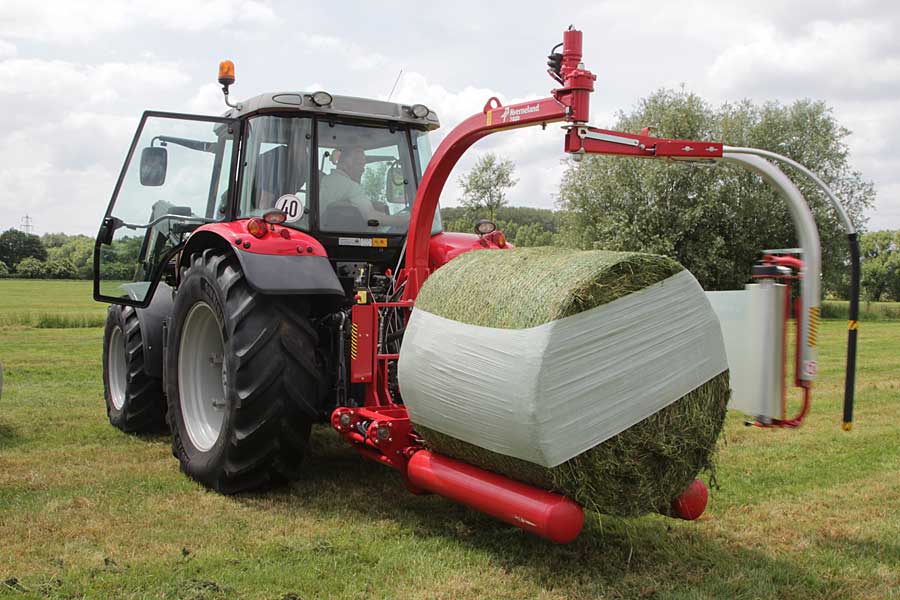Quality Silage
Quality Silage
Ensilaging means preservation of forage by converting the plant sugar into lactic acid. For this reason it is necessary to wrap the bale silage airtight to create an optimum environment with the absence of oxygene to promote the growth and multiplication of lactic bacteria.
The main factors determining the silage-quality can be demonstrated by the ‘Silage Triangle’. A satisfying result can only be expected when forage at the right stage of maturity gets ensiled under suitable weather conditions in combination with the application of the ‘Good Agricultural Practice’. Unfortunately not all quality-determining factors can be influenced to the same extend by the farmer. Especially the variable ‘weather’ is very uncertain and a risk. Nonetheless tools like silage-additives exist to archive a good / sufficient silage-quality even under poor harvesting conditions.
The freshly cut grass is so to speak the ‘raw material’ of the silage. The choose of the right seed mixtures is the basis for the establishment of a vigorous and robust stand to yield a forage rich in energy and nutrients. In many countries local agricultural authorities give useful recommendations for the best seed-mixtures regarding different soil characteristics and climates. Fertilizing and mechanical treatment of the stand (e.g. flattening mole hills with a roller) also play an important role to produce best forage. When weeds become an issue, the composition of forage species moves towards lower quality and /or the stand shows more and more bare spots. A reseeding or overseeding of the pasture / grassland should then be taken into consideration.
The Good Agricultural (Silage-Making) Practice covers all activities starting with the cut of the forage until the monitoring of the stored silage bales. Not only the type of machines used in the silage-making process is important, also the maintenance and correct adjustment of the machinery cannot be overestimated. If mowers cut too deep, soil contamination in the silage can lead to poor fermentation and using dull knives will require more power to mow the crop. Saving money by applying less then 6 layers of balewrap isn’t a good idea as it will increase the risk of dry matter losses and oxygen entering the baleage.
Unfortunately the weather conditions cannot be controlled. So if you have to bale and wrap under poor harvesting conditions the implementation of the above mentioned Good Agricultural (Silage-Making) Practice is of particular importance. Especially silage-making in the wet is a challenge – soil contamination can lead to higher levels of unwanted butyric acid in the silage. Making silage on the dry side may also cause issues when DM goes over 50% and more. Therefore haylage has to be pressed very tightly to exclude oxygen from the bales, otherwise the fermentation is prolonged and may not happen completely. When feeding out the baleage, problems with mould are very likely to arise. In both cases – too wet or too dry harvesting conditions – the application of chemical or biological silage-additives is an option to avoid bad quality silages.

After baling, wrapping and transfering the bales to the storage site the feed quality of the baleage is still not determined. Damages to the balewrap due to carelessness can result in warming and spoilage caused by the development of mould and yeast. So all previous efforts to produce high-quality silage would be in vain. Again the Good Agricultural Practice is the key to deliver only best forage.
Quality-silage can be recognized by its smell, colour and consistency. Good forage has an aromatic smell without any unpleasant notes of butyric acid, vinegar or other odors. Heating is oftenly noticable by a smell of burnt tobacco or by a mouldy or muffy smell. Small white dots on the plant material indicate the precence of yeasts. Steamy warm or even hot silage is certainly not a high-quality forage. The enery of the fodder literally disappears in the air.
While humid silages with a low content of DM usually show a stronger green colouring, silage from over-mature forage with a higher content of DM has a more pale appearance, which reminds of hay. In principle, the colour of a good silage / baleage should correspond to that of the starting material.
The structure of the silage should also come close to that of the fresh forage. Greasy and soapy qualities indicate spoilage and decay of plant material caused by harmful microbes.
But the final judgment on the silage-quality is given by the animals. Despite all care taken in the production of baleage feed refusals without obvious reasons may occur. They indicate quality issues which can only be discovered by a feed analysis. Equally the energy level of a silage is not visible and can likewise only be determined by a feed analysis.